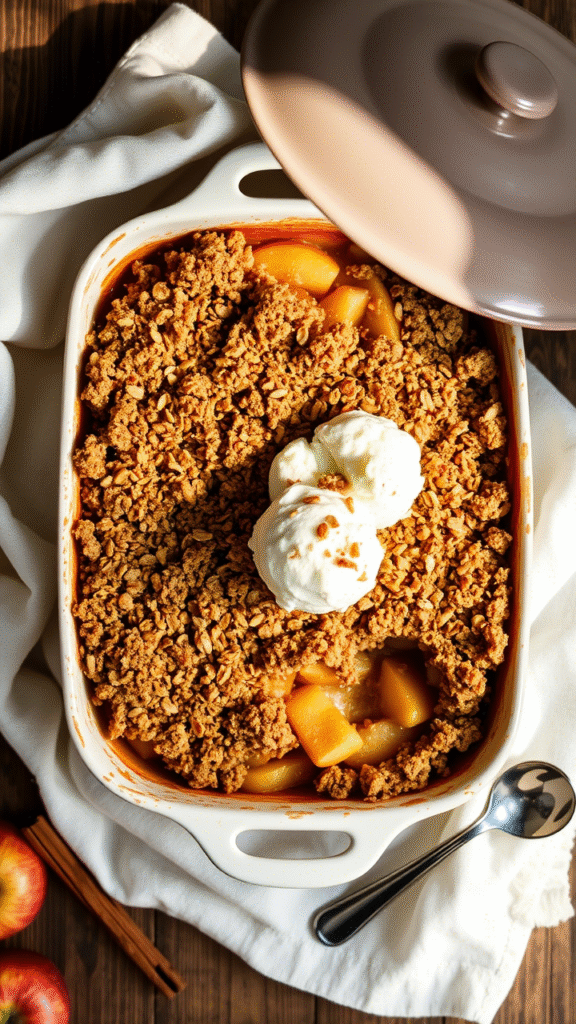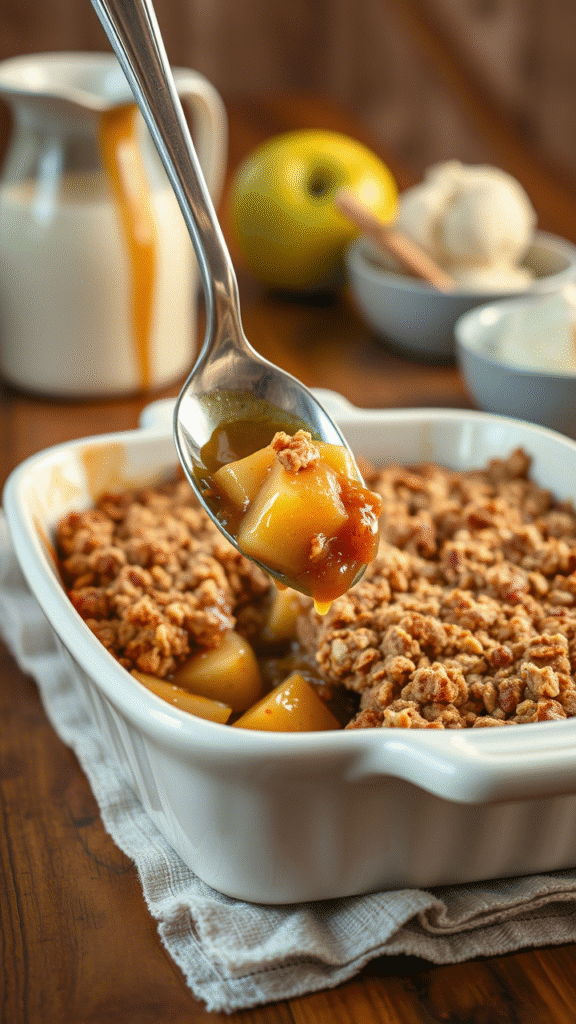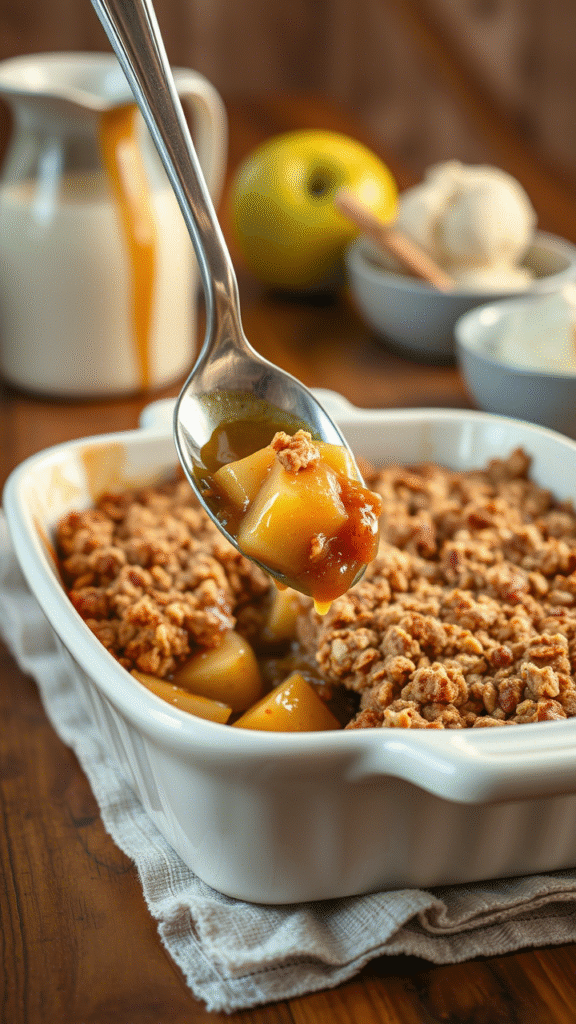Ever had a dessert that tastes like a warm hug? Classic apple crisp does just that. It’s not just a dish; it’s a ritual. The scent of cinnamon, the crunch of the topping, and that juicy, tender apple filling—it’s a symphony on the tongue. This isn’t just a recipe; it’s a love letter to fall, to family kitchens, to memories baked and shared. If you think apple pie is the only king of apple desserts, wait till you get a taste of a crisp that’s simple, soulful, and so dang satisfying.
Apple crisp is the kind of dessert that bridges generations and regions. Born from humble roots, it celebrates seasonal apples and the comforting crunch of oats and brown sugar. Unlike a pie with its complicated crust, the crisp lets the fruit shine, crowned with a buttery crumble that’s flaky and golden. But there’s more beneath the surface: subtle science in how heat transforms starches, textures that contrast just right, and the alchemy of spices that warm from the inside out.
Ingredients & Substitutions: The Heart of a Great Apple Crisp
Here’s what you’ll need:
- 6 cups apples (peeled, cored, sliced) — a mix of tart and sweet apples works wonders (Granny Smith & Honeycrisp, anyone?)
- 1 cup old-fashioned rolled oats — for that iconic crunchy topping
- 1 cup all-purpose flour — the base of the crumble, though we’ll talk alternatives
- ¾ cup brown sugar (packed) — light or dark, it adds deep caramel notes
- 1 tsp ground cinnamon — the spice that sings with apple
- ½ tsp ground nutmeg — subtle warmth, not overpowering
- ½ tsp salt — to balance sweetness
- ½ cup unsalted butter (cold, cubed) — key for a flaky topping
- 1 tbsp lemon juice — to brighten the apple filling and prevent browning
Now, substitutions. Got dietary restrictions? No worries. Swap all-purpose flour for almond flour for gluten-free folks. But be aware, almond flour makes the topping a bit more tender, less crispy. Oats can be replaced with gluten-free oats, but steer clear of instant oats—they turn mushy when baked. Butter can be swapped with coconut oil or vegan butter to make it dairy-free, but be mindful that the flavor will shift slightly—coconut oil adds a tropical hint. Brown sugar? Maple syrup can be used but reduce the liquid in the filling a little, since syrup is liquidy and will affect texture.
Selecting the right apples? Avoid waxy supermarket varieties that don’t cook down well. The best are those that keep their shape but still soften—think Granny Smith for tartness and Pink Lady for sweetness. You want apples that get tender but don’t dissolve into mush. This texture balance is the unsung hero of the dish.
Step-by-Step Instructions: Crafting the Perfect Crisp

- Prep the apples: Toss your sliced apples with lemon juice, cinnamon, nutmeg, and a pinch of salt in a big bowl. This step isn’t just about flavor. The acid from lemon juice slows enzymatic browning and helps the apples release just enough juice while cooking—not too much, or the crisp turns soggy.
- Make the topping: In a separate bowl, combine oats, flour, brown sugar, and salt. Toss in the cold butter cubes. Now here’s the trick—use your fingers or a pastry cutter to work the butter into the dry ingredients until the mixture looks like coarse crumbs. Tiny pea-sized lumps are perfect. Overworking it will result in a tough topping.
- Assemble: Pour the apple mixture into a buttered 9×13-inch baking dish. Even it out gently. Sprinkle the crumble topping evenly over the apples. For best texture, don’t press it down.
- Bake: Preheat your oven to 350°F (175°C). Bake uncovered for 45-50 minutes or until the topping is golden and the filling bubbles at the edges. The bubbling is a sign the juices have thickened just right—too early and the filling’s undercooked, too late and it could be dry.
- Cool slightly before serving: This helps the juices thicken further, preventing it from running everywhere when you scoop it out.
A common slip? Using too soft apples or cutting them too thin. Both can lead to a mushy disaster. Also, watch your butter temperature for the topping—too warm and it melts into the flour, killing that crumbly texture.
Want a twist? Add chopped pecans or walnuts into the topping for extra crunch. Or, for a spicy kick, add a pinch of cayenne pepper to the crumble—sounds wild but trust me, it’s magic with cinnamon.
Cooking Techniques & Science: What Makes Apple Crisp Work?

Here’s where it gets nerdy, and I love it. Baking the apples in a crisp instead of boiling or stewing retains the fruit’s structure. Heat breaks down pectin—a natural thickener—in the apples slowly. This process thickens the filling as it cools, giving you that jammy, luscious texture without extra thickeners.
The cold butter in the topping is key. As it melts during baking, it creates steam pockets, which make the crumble delightfully flaky. Too warm and you’ll get a dense, greasy mess. The oats add chew and texture because their beta-glucan fibers absorb juices and soften without losing shape.
You might wonder why no eggs or chemical leaveners here? Because apple crisp’s texture doesn’t need rise. It’s about contrast—the tender, sweet, tart apple filling against a crunchy, nutty topping.
Tools matter too. A glass or ceramic baking dish is best because it distributes heat evenly and retains it well. Metal pans can brown the topping too quickly or unevenly.
Serving & Pairing Suggestions: Making It Shine

Apple crisp is best served warm. A scoop of vanilla bean ice cream melting over the crumble? Classic and irresistible. Or a dollop of freshly whipped cream, lightly sweetened with a hint of vanilla, works wonders. For an adult twist, drizzle a splash of bourbon or spiced rum on top right before serving—complex, boozy notes cut through the sweetness beautifully.
Presentation-wise, rustic is perfect here. Serve it in the baking dish for that homey vibe, or plate small portions in shallow bowls to highlight the layers—golden topping, glossy apples beneath. Sprinkle a tiny pinch of flaky sea salt over the warm crumble to elevate all the flavors even more.
Pair it with a hot cup of spiced chai or a crisp dry cider. The cider’s acidity complements the apples, while chai spices echo the cinnamon and nutmeg.
Conclusion: The Enduring Charm of Classic Apple Crisp
Apple crisp isn’t just dessert. It’s a sensory celebration—of texture, aroma, flavor, and memory. What makes it special is its simplicity, but also its subtle complexities—the choices of apple, butter, and spice, the texture contrasts, the aroma that fills the kitchen.
Remember, the key is balance. Not too mushy apples, not too wet topping. The butter must be cold, the baking time precise. Don’t be afraid to experiment with nuts, spices, or even swap sugars to tailor it your way.
If you nail the crisp, you’re not just baking dessert—you’re creating moments that linger long after the last crumb is gone.
FAQs
Q1: Can I make apple crisp ahead of time?
Yes, prepare the topping and apple filling separately, then assemble just before baking. You can also bake it a day ahead and reheat gently to preserve the crispiness.
Q2: What apples are best for apple crisp?
Go for a mix of tart and sweet apples like Granny Smith, Honeycrisp, or Pink Lady. They hold their shape and offer flavor complexity.
Q3: How do I prevent the topping from getting soggy?
Keep butter cold and don’t press the crumble onto the apples. Also, ensure the baking time is long enough for moisture to evaporate and juices to thicken.
Q4: Can I use frozen apples?
Frozen apples work but expect more liquid. Thaw and drain excess juice before assembling to avoid a watery filling.
Q5: How do I make a gluten-free apple crisp?
Use gluten-free oats and substitute all-purpose flour with almond or oat flour. Adjust butter accordingly for texture.

Food lover, recipe creator & the heart behind NoshCrafters.com. Olivia shares mouthwatering, easy-to-make dishes that turn everyday meals into unforgettable bites. When she’s not experimenting in the kitchen, she’s busy plating up inspiration for home cooks everywhere.